The true origins and evolution of Eddie Van Halen's legendary Frankenstein guitar
How the most famous guitar in rock history took shape and spawned a mythology all of its own

The legend of Eddie Van Halen’s Frankenstein guitar is almost biblical: “In the beginning, Eddie Van Halen went to Charvel and bought a Boogie Bodies neck and body.
He installed thereupon a PAF humbucker and Stratocaster tremolo, then cut by hand a pickguard from blackest vinyl and painted the body with black and white stripes, representing the forces of darkness and light. He plugged the magnificent creation into his Marshall plexi amp, and proclaimed ‘Let there be rock!’ And it was good.”
However – to paraphrase Runnin’ with the Devil – the simple things aren’t so simple. As Brad Tolinski and I were working on our upcoming book, Eruption: Conversations with Eddie Van Halen (Hachette Books), we dug deep into research and fact-checking to answer and verify numerous questions, such as when Ed started tapping, what exact date did Ted Templeman discover the band and, particularly, when exactly did Ed build the Frankenstein guitar.
I personally searched for every available early photo I could find to stitch together a plausible timeline, dug through old newspapers and fanzines and sought credible witnesses. Along the way, I visited numerous online forums and sifted through various theories, assumptions, facts, myths and arguments to extract the facts and most logical explanations.
One of the most puzzling but fascinating photos I found was a lo-res black-and-white image that I, amongst many other Van Halen guitar fanatics, first viewed when it appeared on a handful of forums in 2014.
The photo shows Ed playing a guitar with an unfinished Strat-style body, rosewood neck, “zebra” bobbin humbucking pickup and two control knobs. Inserted in the image is “A younger Eddie shreddin’ at the Whiskey (sic) A Go-Go 1977” and “courtesy of inertia graphics ©2001.”
The stage lights in the background are consistent with those of the Whisky at the time, and, since Van Halen’s very first gig at the Whisky took place on December 3, 1976, the 1977 date seems accurate, albeit frustratingly vague.
Get The Pick Newsletter
All the latest guitar news, interviews, lessons, reviews, deals and more, direct to your inbox!
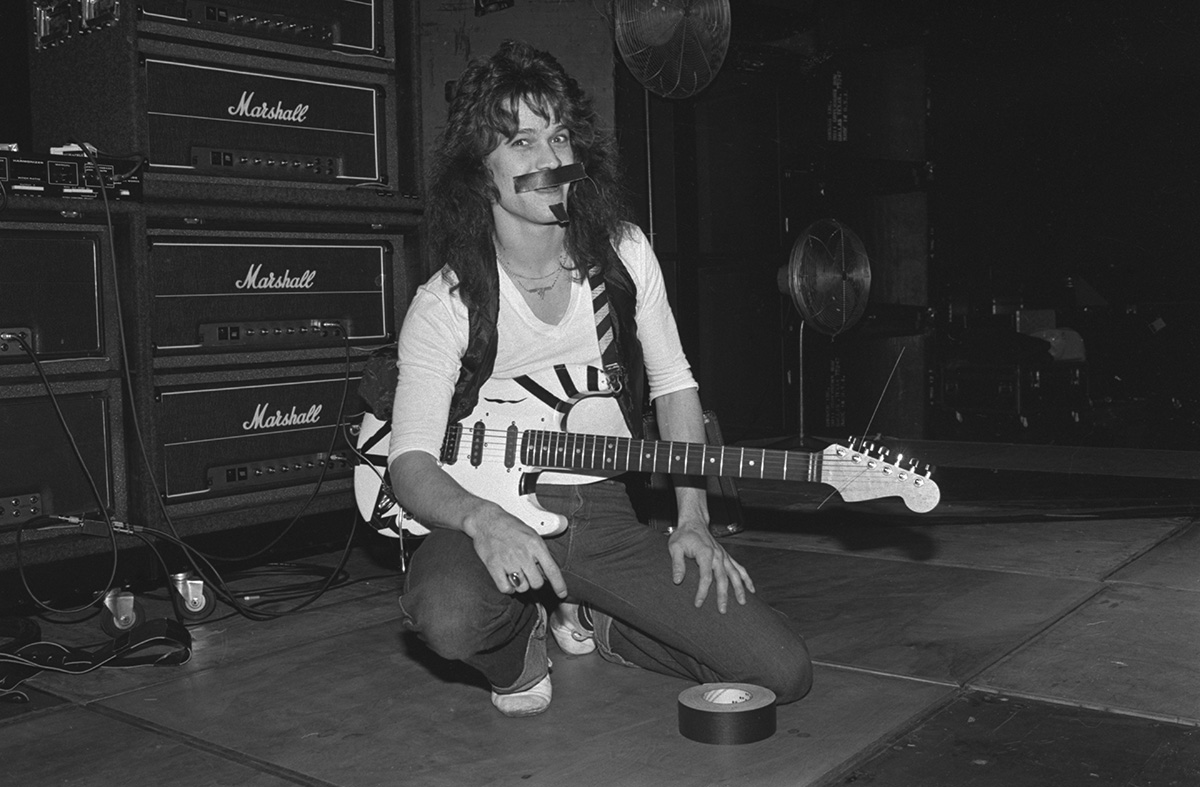
The most convincing detail that suggested that the guitar body in the photo was Ed’s Frankenstein was the black pickguard. Directly below the volume knob is a notch that’s identical in shape and placement to the notch seen in numerous photos of the Frankenstein when it had the black-and-white striped finish.
Although the photo is not particularly sharp, close examination of the body’s wood grain also reveals features consistent with those of a factory second, which is an attribute that Ed and others consistently mentioned about the body he bought from Charvel. My efforts to track down the person behind Inertia Graphics to see if he or she could remember a more precise date or provide a hi-res version of the photo (or additional photos) were a dead end.
However, as I searched for more details about that photo, I came across a YouTube video posted May 2020 by Johnny B Guitars titled “Bare Body Frankenstrat Mysteries Revealed” that led me far deeper down the rabbit hole than I could have dreamed.
In addition to the 1977 Whisky photo, the video also featured photos taken by Bo Shannon in 1977 of Ed playing the bare body guitar. Shannon’s photos showed several angles of the guitar in much sharper focus and detail.
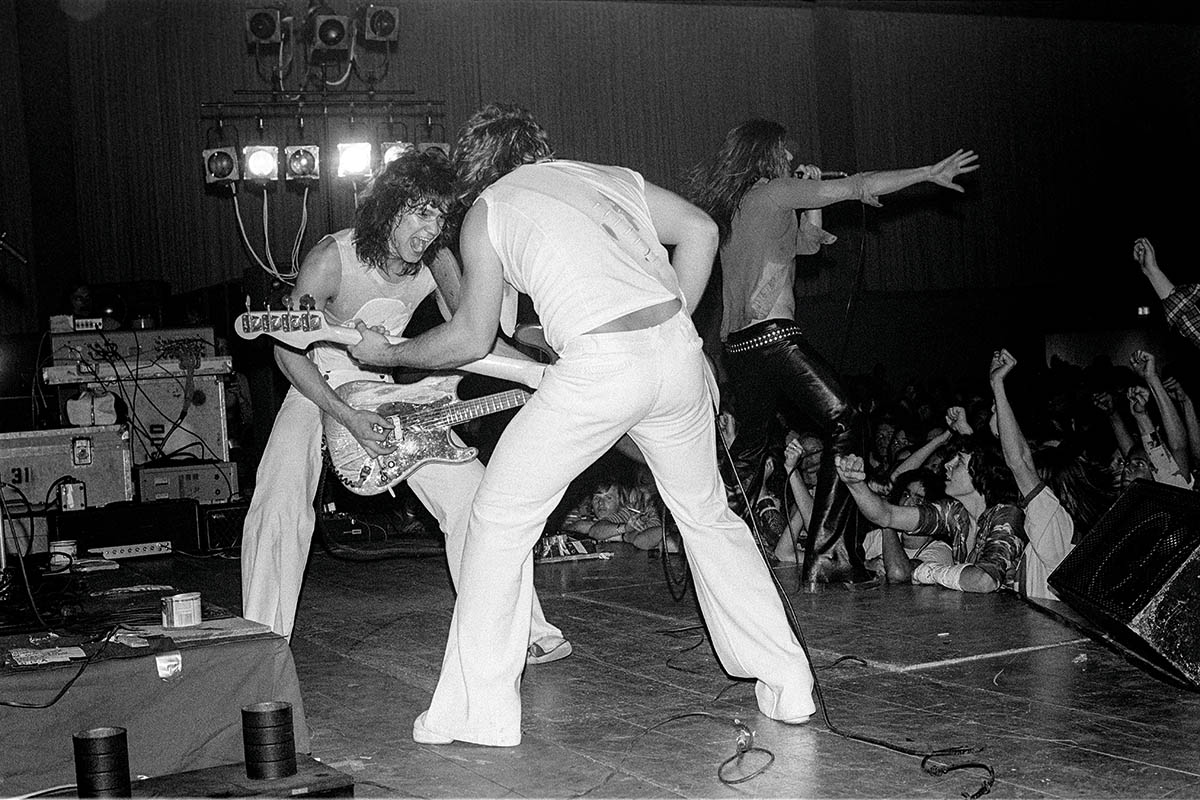
After viewing the video, I searched for more of Shannon’s Van Halen photos online and came across a handful of additional images that show Ed playing a white Stratocaster with a humbucking pickup at the bridge.
This was the beginning of my own personal revelation (which several other online sleuths discovered before me) as Shannon’s photos and the dates he provided helped me answer numerous questions about when and how Eddie Van Halen’s Frankenstein came into existence.
The puzzle pieces were all there, and everything started to make perfect sense. I would like to extend a warm thank you to Bo Shannon for making his photos available and providing fascinating details about them.
John Burgess of Johnny B Guitars also deserves kudos for his outstanding research and excellent YouTube videos, which also include highly recommended “How Eddie Van Halen painted the Frankenstrat” and “Black Frankenstrat?! 1977 Whisky A Go Go.”
Guitar World readers may already recognize Burgess as the builder of the hockey stick and stop sign guitars featured in the It Might Get Weird column back in 2013 and 2016.
His meticulous, scholarly research and fastidious analysis are truly commendable, and he has proven to be an excellent resource for those of us seeking the truth and facts.
What follows is the background, development and evolution of Ed’s Frankenstein guitar up until and including the period just after he applied red paint to it in 1979. After that period, Ed frequently swapped necks, pickups and hardware in his ongoing quest to build the perfect beast and stay several steps ahead of his imitators.
As the catalyst and prototype for the “super Strat,” the most popular electric guitar design to emerge since the Gibson Les Paul and Fender Stratocaster and Telecaster designs of the Fifties, Eddie Van Halen’s Frankenstein was indeed a monster of a guitar.
The Origin of the Species
The origin of the Frankenstein guitar arguably begins in August 1969, when Ed and his brother Alex went with their father, Jan Van Halen, to Music for Everyone in Sierra Madre, California.
Jan made a $143 down payment consisting of a $20 bill and $123 in trade-in credit for a Bundy flute and Ed’s Univox Custom 12-string guitar to purchase a $200 Cooper drum kit for Alex and a brand-new $400 goldtop Gibson Les Paul Standard for Ed.
Although Ed finally had a professional-quality instrument in his hands, he soon discovered that the ’69 Les Paul’s single-coil P90 soapbar pickups didn’t deliver the same fat, harmonically rich tone as the humbucker-equipped Les Paul and SG guitars played by his hero Eric Clapton on Ed’s favorite Bluesbreakers and Cream albums.
Instead of buying yet another guitar, Ed acquired a spare humbucking pickup, chiseled out a larger cavity at the Les Paul’s bridge position and installed the humbucker.
A few years later during the mid Seventies after Ed graduated from high school, he further modified the Les Paul by painting it black, probably in either late 1974 or ’75.
The Les Paul was stolen around this time, and it appears that Ed bought a brand-new Ibanez model 2387 Flying V copy to replace it. A photo taken during this period shows Ed playing the V at a gig with its stock dual cream-bobbin Hi-Power humbucker at the neck position and a replacement nickel- or chrome-cover Gibson-style humbucker installed at the bridge.
Unfortunately, the V was stolen as well, but the replacement he bought during the second half of 1975 was an even better upgrade – a 1975 Ibanez Destroyer with Super 70 pickups.
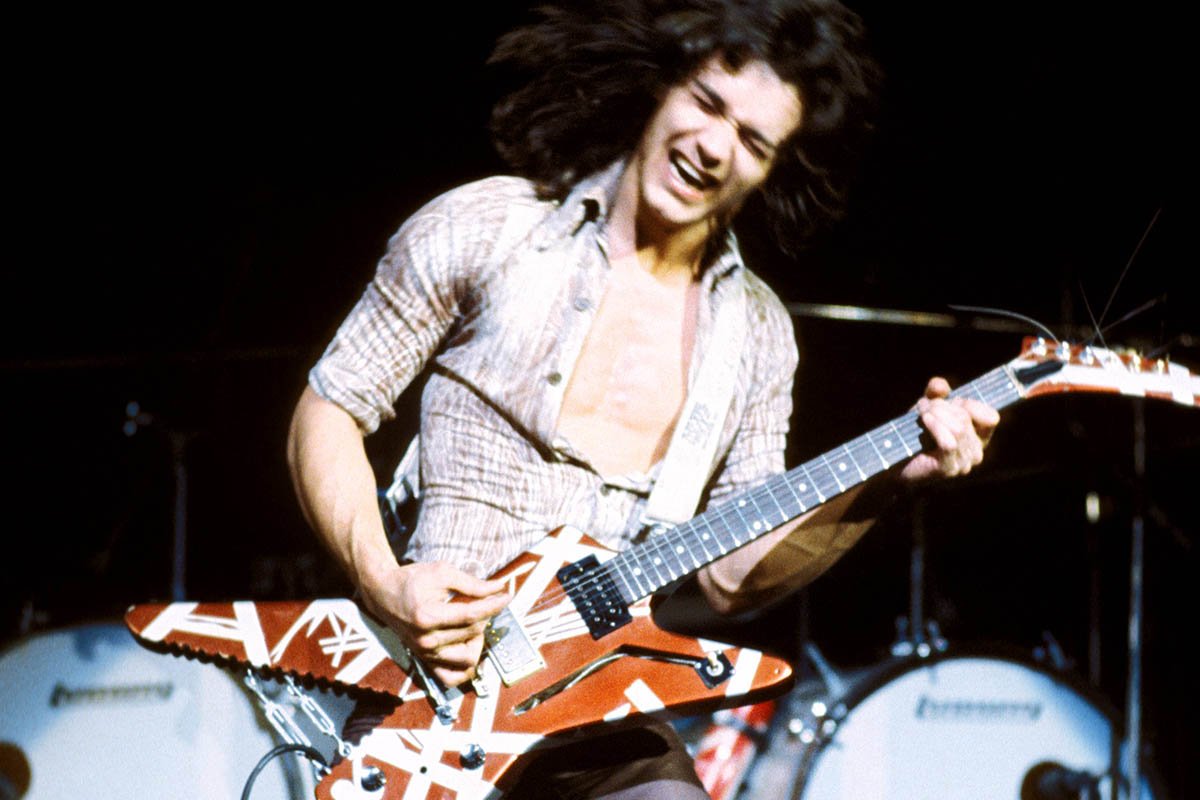
Ed finally found a guitar that satisfied his ever-discriminating taste for tone, and over the next two years he made only minor modifications to it, including refinishing it in white and swapping the control knobs and bridge. Ed acquired two other important guitars around this time: a circa 1963-65 Gibson ES-335 and a 1958 Fender Stratocaster.
The only known photo of Ed playing the 335 appeared in the 1975-76 yearbook for Don Bosco Tech high school. The photo quality isn’t the greatest, but details like the block inlays, vibrato tailpiece and sharper cutaway horns all confirm that the 335 is a 1963 or later model.
“It had one of those Maestro Vibrola wiggle sticks with the bent metal tailpiece, like you find on an SG,” Ed said. “I liked it, but it wouldn’t stay in tune. I sawed the bent metal spring in half, figuring I could make the E, A and D strings solid and just have the high three strings affected by the wiggle stick. I did all kinds of crazy shit to that 335. I took a belt sander to it when I wanted to repaint the guitar white, but I ended up sanding a big hole through the wood.”
Ed’s fascination with the vibrato bar probably led him to the ’58 Strat next, but he quickly got rid of it after his bandmates complained about the thin sound of its single-coil pickups. Although his bandmates hated the Strat’s tone, Ed loved how he could perform deep dives with its vibrato bar and keep the vibrato reasonably in tune with a few custom tweaks.
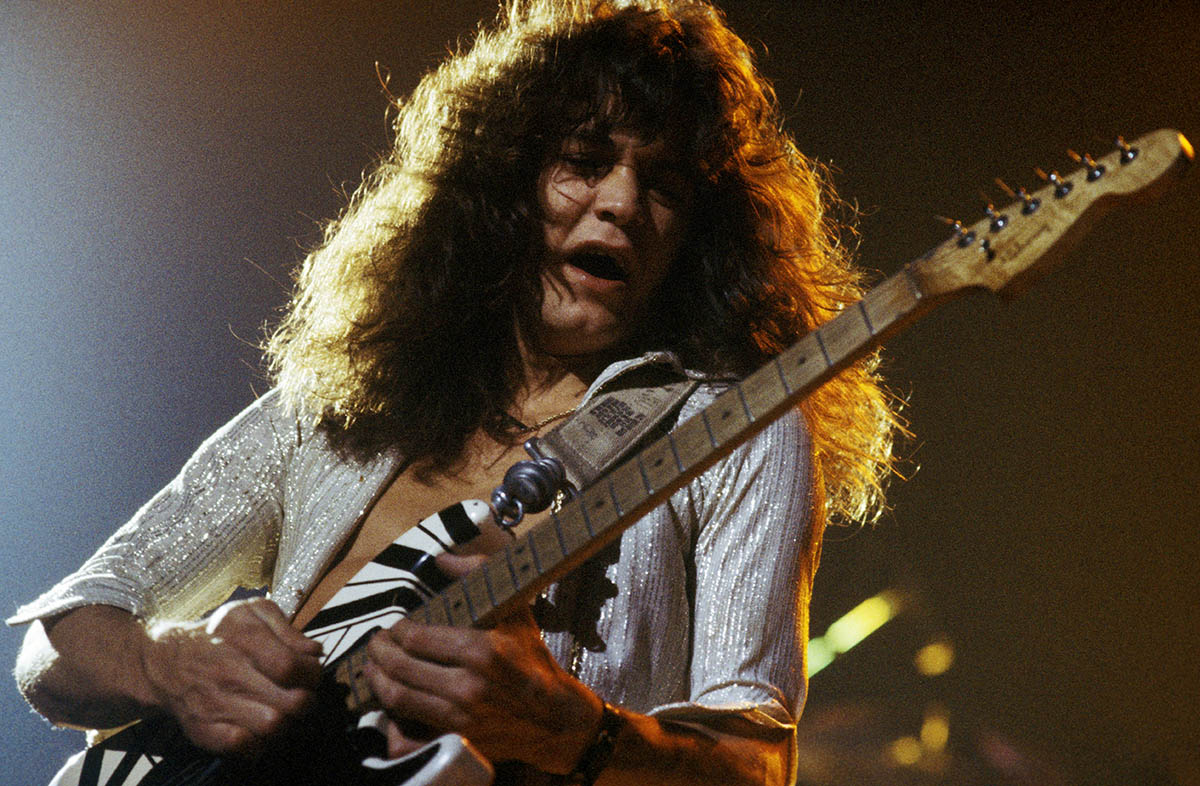
Best of Both Worlds
In early 1976, Ed had reached a crossroads. While he loved the fat, aggressive tone of his Ibanez Destroyer, which was then his main guitar, he also loved the creative, expressive potential of a Strat’s vibrato. The guitarist imagined two different ways he could combine the best features of both – either install a Strat vibrato on his beloved Destroyer, which would require a costly, invasive routing job, or install a humbucking pickup on a Stratocaster.
The latter was the easier and cheaper solution. During mid to late 1976, Ed was photographed at the Starwood (where Van Halen first played in May 1976) and Whisky A Go Go (where they performed their first gig on December 3, 1976) nightclubs playing both his white Ibanez Destroyer and a sunburst Fender Stratocaster.
Ed had recently started spending time at Wayne Charvel’s repair shop in Azusa, California, where he bought replacement parts for his guitars and absorbed tips about guitar construction and modifications. Wayne probably sold the Stratocaster to Ed during one of those visits.
The Strat was an alder-body 1961 model, confirmed by its slab rosewood fretboard, small pre-CBS headstock, wide 12th fret dot inlay spacing, screw placement for the mint-green three-layer pickguard, three-color sunburst finish and other distinguishing features. Interestingly, the stamped serial number on the neck plate found on Ed’s Frankenstein guitar – 61071 – is also consistent with a 1961 Fender, so it apparently came from this guitar.
One notable feature of Ed’s ’61 Strat was the peculiar placement of a 1967-era Fender decal in the center of the headstock, instead of along the lower edge. The theory is that Wayne probably refinished the neck and hastily applied a New Old Stock decal from a stash he acquired while he was employed by Fender. This anomaly provided a fortuitous “fingerprint” for Ed’s later experiments, although it also has thrown a few sleuths off the track. More on that later.
The earliest photos of Ed with the ’61 Strat show a black-and-white zebra bobbin humbucker (probably a Mighty Mite 1300 or 1400, which was a replacement pickup that Charvel sold in addition to DiMarzio pickups) placed a generous distance from the bridge, with the humbucker at the same angle as a Strat bridge pickup and the lower coil in about the same location as the Strat bridge pickup.
The Strat had only two control knobs (the knob at standard volume position is missing), and the pickup selector switch was taped in the center position. This guitar is essentially “the dad of Frankenstein.”
It’s impossible to determine if Ed chiseled out the larger cavity to install the humbucker or whether Charvel routed the cavity for him. The missing volume knob and taped pickup switch suggest that Ed installed the pickup himself and did the wiring, which is consistent with his frequent statements about not knowing how to wire the extra pickups. Ed didn’t use them anyway, so why should he bother?
Perhaps Ed wired the humbucker to the switch so it only worked in the center position, which could explain why it was taped in place. Later in 1976, a humbucker with dual cream bobbins – most likely a DiMarzio Super Distortion – appeared in the bridge position, this time positioned slightly closer to the bridge and at a shallower angle.
Ed switched the control knobs from stock Strat knobs to white speed knobs, with the Strat knobs now appearing on Ed’s Destroyer. The pickup switch was usually seen set to the neck position, but it probably was completely disconnected when the new humbucker was installed after Ed realized that he didn’t need the switch at all.
The humbucker-equipped ’61 Strat remained in the same configuration throughout most, and possibly the remainder, of 1976. This can be confirmed by Marvin Rinnig’s photos shot at the Whisky A Go Go. As I mentioned earlier, Van Halen’s first gig at the Whisky took place on December 3, 1976.
Rinnig confirmed that he shot Van Halen at both the Starwood and Whisky, and his Whisky shots can be identified by several details, including the stage lighting configuration (the Whisky’s rear stage lights were PAR fixtures directed in different directions while the Starwood’s rear lights were a straight bank).
In Rinnig’s Whisky photos, the Strat still had a sunburst finish. Sometime between Van Halen’s first gigs at the Whisky and mid January 1977, Ed painted the ’61 Strat white.
Apparently he just sprayed the white paint over the original sunburst finish, as photos taken by Bo Shannon at the Starwood in mid-January show several finish chips that expose much darker paint underneath.
An undated set of amateur fan photos that appear to be taken at the Whisky show Ed also playing the white Strat. If the venue is indeed the Whisky, the photos could have been taken either previously (as late as December 22) or afterwards (as early as January 27). Either way, the white ’61 Strat existed for only a very brief period.
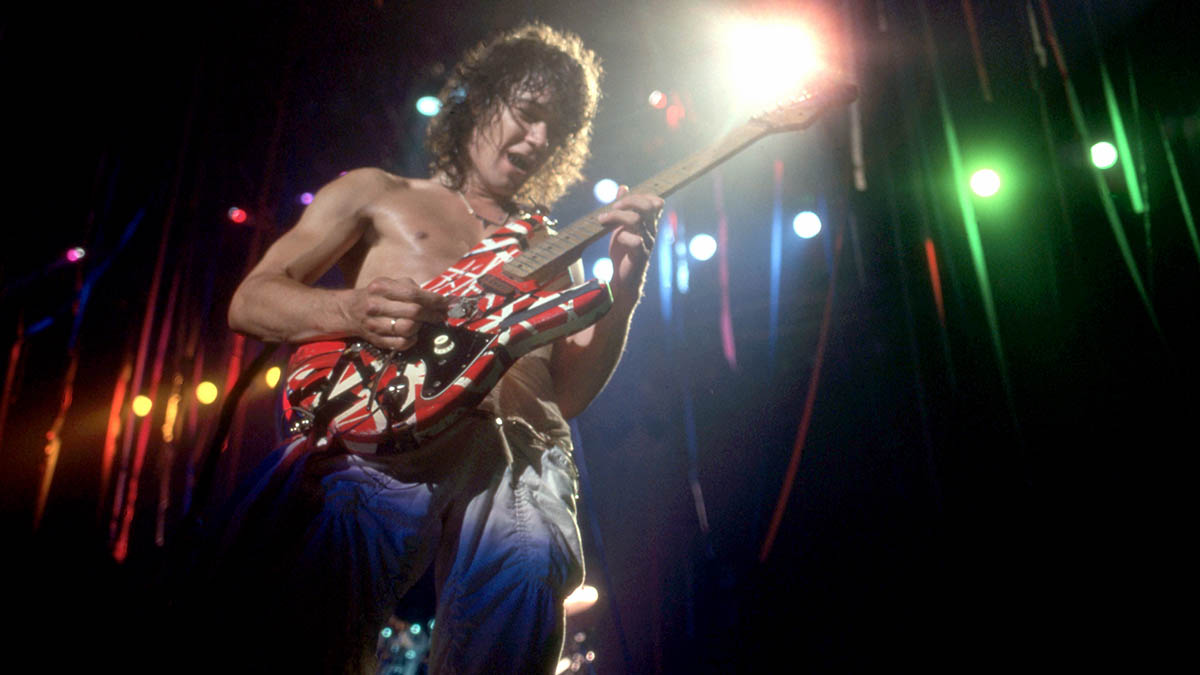
It's A Monster
Considering that Ed took the time to strip the parts off of his ’61 Strat, spray it white and put it back together again, he apparently still favored that guitar as one of his main stage instruments as late as mid January 1977.
However, about a month later he was photographed playing a guitar with a bare, unfinished ash body, black pickguard and single Mighty Mite humbucker with zebra bobbins. The guitar also had the same rosewood fingerboard neck (with odd headstock decal placement), vibrato tailpiece and 61071 serial number neck plate from his ’61 Strat, so the white ’61 Strat was now obviously disassembled.
What trips me out is that when I painted the Frankenstein red that made it more famous. A lot of people still don’t know that it’s the same guitar as the black and white guitar on the cover of the first Van Halen album.
The earliest photo of the bare body guitar with a confirmed date was taken on February 18, 1977, at the Pasadena Civic Auditorium by Bo Shannon, who shot photos and wrote concert reviews for the Fullerton Daily News Tribune. The aforementioned Inertia Graphics/Whisky bare body photo could have been taken soon before or after, but the exact date is unknown.
The unfinished body is what Ed frequently described as the famous factory second Boogie Bodies body that he purchased from Charvel for $50. It is definitely not the alder ’61 Strat body with the finish stripped, as the grain patterns visible in the sunburst finish photos do not match.
The photos of the unfinished body reveal several details that identify it as a second, including mismatched grain patterns, an angled center seam, a knot in the treble cutaway pocket and more (explained in impressive detail in the Johnny B Guitars “Bare Body Frankenstrat” YouTube video). More importantly, the grain patterns also match the sections of grain visible on the Frankenstein guitar’s body in its current state.
Thanks to Shannon’s photos, we can date the origin of Ed’s Frankenstein guitar (as a playable instrument and not unassembled parts) to sometime between Shannon’s mid-January Starwood photos and the February 18, 1977, Pasadena Civic photo.
Although Ed had stated that he built the guitar in either 1974 or ’75, and even New York’s Metropolitan Museum took his word and attributed 1975 as the Frankenstein’s date when the original guitar was displayed at the “Play It Loud” exhibit in 2019, Charvel did not start stocking and selling Boogie Bodies parts until late 1976.
In 2006, Chip Ellis of FMIC’s Jackson/Charvel Custom Shop told me that he saw a Boogie Bodies stamp in the neck pocket of the original Frankenstein guitar when he was making the EVH Frankenstein Tribute model.
However, Wayne Charvel has said on numerous occasions that he sold Ed “an older body that I had constructed in my shop,” and several researchers have made convincing arguments that the body may indeed have been made by Charvel and his employee Dave Schecter, and not by Lynn Ellsworth/Boogie Bodies as previously assumed.
Regardless of who actually built the body, it was made sometime in 1976 before Ed bought it, so Ed couldn’t have built the Frankenstein any earlier than then. Ed started playing the Frankenstein during a very important time in Van Halen’s career.
Producer Ted Templeman first saw the band at the Starwood on February 2, 1977, and two days later Van Halen signed a letter of intent (an agreement preceding a more formal recording contract) with Warner Bros.
It’s possible the Ed could have played the guitar with the Frankenstein body at the first shows that Templeman witnessed. Perhaps this humble slab of wood, rescued from the scrap heap by Ed, was the guitarist’s talisman, enchanting him with good fortune that led to his fame, success and acclaim from that point onward.
The next widely available and accurately dated photos of Ed playing guitar were taken at the Whisky A Go Go on May 29, 1977, by Kevin Estrada and Jenny Lens. Ed was now playing a guitar with a Strat-style body, black finish, mint/white pickguard, zebra humbucker and two single-coil pickups, single control knob and the rosewood ’61 Strat neck.
The pickguard, single-coil pickups and particularly the distinctive ’61 neck led many to assume that this was the ’61 Strat refinished black, but closer examination confirms that the guitar actually has the Boogie Bodies/Charvel/Frankenstein body.
Perhaps this humble slab of wood, rescued from the scrap heap by Ed, was the guitarist’s talisman, enchanting him with good fortune that led to his fame, success and acclaim from that point onward
John Burgess’s “Black Frankenstrat” video provides definitive proof, including the cutaway pocket knot, paint drips that match those on later iterations of the Frankenstein, identically placed screw holes from both the homemade black and ’61 mint green pickguards and other details.
The black finish later provided the base for Ed’s black and white striped graphic design, which he created by taping sections of the black body, spraying several layers of white paint and removing the tape.
This leads to an important question: When exactly did Ed paint Frankenstein’s iconic black and white striped finish? Amateur fan photos reportedly taken at the Whisky July 15, 1977, by Kat Hanes and possibly at the same show by another anonymous fan show the guitar with the striped finish.
If the date is correct, these are the first known shots of the black and white Frankenstein. The black pickguard is also back, and the anonymous fan’s photo clearly shows that a black-bobbin humbucker (probably salvaged from Ed’s wrecked circa 1963-65 Gibson ES-335) replaced the zebra Mighty Mite.

A very fascinating detail is the presence of two white Strat control knobs. Was the circuit wired with a volume and tone control or possibly two volume controls, or was one extra knob just there for looks?
The next inevitable question is: Where was the famous Boogie Bodies neck? Ed and Wayne Charvel’s statements led many to believe that Ed purchased the body and Boogie Bodies neck at the same time, but the neck does not appear until those same July 15, 1977 Whisky photos shot by Hanes and an unknown source.
The most likely explanations are that Ed either bought the neck during a later visit to Charvel, or he custom-ordered the neck and it took a few months for Ellsworth to complete and deliver it.
Ed’s neck was consistent with the custom specs listed in Charvel’s 1977 catalog for a Style C “flatter-wider Gibson-style” fretboard with standard jumbo frets, and the $89.95 price is close to the $80 that Ed said he spent for the neck.

The Frankenstein looks identical in a pair of photos that Kat Hanes took one month later on August 15, 1977, at the Magic Mountain amusement park in Valencia, California. Unfortunately, the pickup is very hard to see in clear detail. Ed’s white Ibanez Destroyer, with its body still fully intact (Ed made the “shark” modifications after recording Van Halen’s debut album), is also seen in the background.
Considering that the Magic Mountain photos were taken exactly two weeks before Van Halen started recording their debut album at Sunset Sound on August 29, it’s highly probable that the Frankenstein still had two control knobs and the Gibson pickup during the debut album sessions.
The October/November 1977 #4 issue of the hard rock fanzine Raw Power features yet another early photo of Ed playing the striped Frankenstein with two control knobs (a PDF of the issue can be downloaded from scott-stephens.com). Here the pickup is difficult to see as well, but both bobbins appear to be black.
The photo was likely taken either August 19-20 or September 16-17 at the Whisky, either shortly before or right after Van Halen’s debut album sessions. The accompanying interview with David Lee Roth suggests that the album was already recorded, so the September date seems more plausible.
This also supports the likelihood that the black-bobbin, patent-pending decal ES-335 humbucker was in the Frankenstein during the sessions – technically not a PAF as Ed stated, although the patent decal version is very similar to many PAFs with the exception of its slightly smaller Alnico 5 magnet.
The August 1977 issue of the punk fanzine Slash provides fascinating clues that support a possible inspiration for Ed’s signature striped guitar finish.
A review of several consecutive punk shows at the Whisky from June 20-22, 1977, appears on pages 19 and 20. The review for the second night states, “Van Halen paraded around in what they had been led to believe were the latest punk outfits,” and a photo of Roth and the Van Halen brothers in those outfits is on the issue’s rear cover.
The review section covers two shows by the Dils at the Whisky – one on June 22 and a gig at a later date. The review is accompanied by a photo on page 20 of Dils guitarist Chip Kinman playing a white Les Paul Custom copy adorned with black electrical tape at criss-crossing angles. It looks uncannily similar to, albeit much cruder than, Ed’s black and white Frankenstein design.
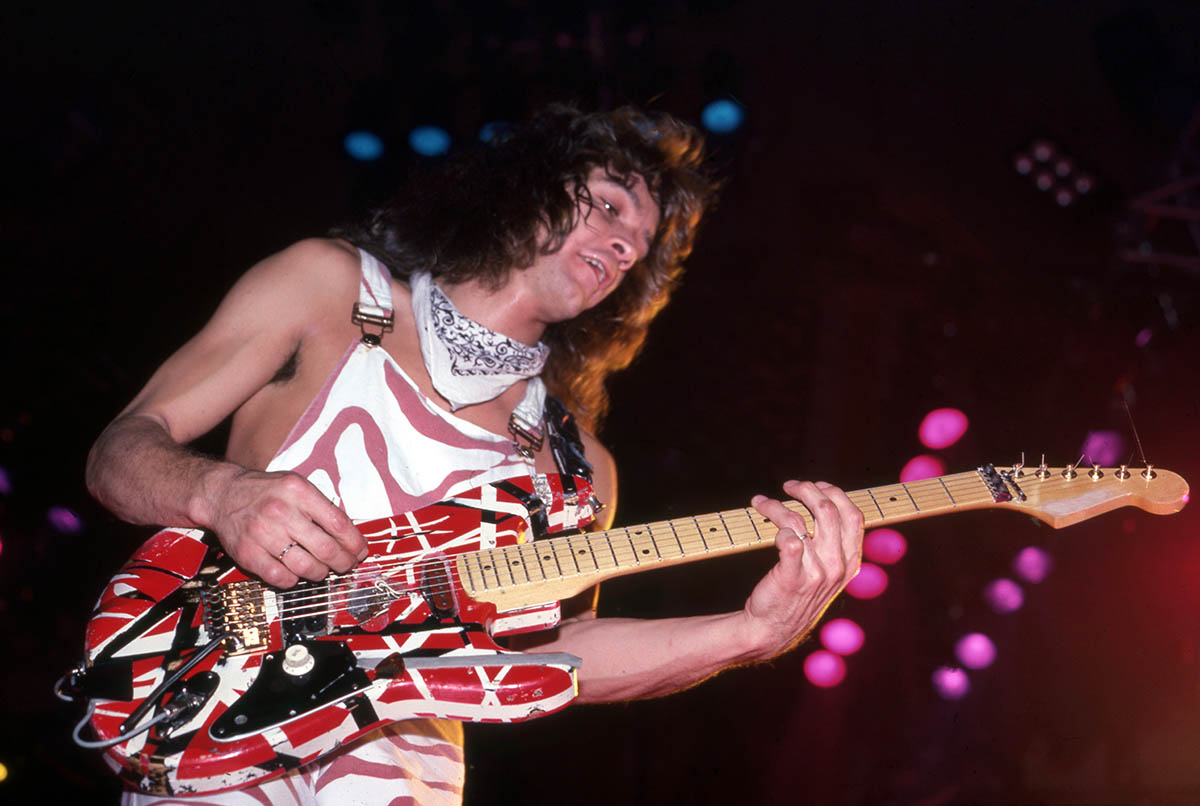
Van Halen attended numerous punk shows at the Whisky during the summer of 1977 in the downtime between recording their demos and the album. During this timeframe they even wrote several new songs (Ain’t Talkin’ Bout Love, Loss of Control and Atomic Punk) that were Van Halen’s unique interpretation of punk.
It’s plausible that Ed saw at least one Dils gig at the Whisky in June or early July. Kinman recalls seeing Van Halen at several of the Dils’ gigs at the Whisky and telling his bandmates, “the hippies are here again.”
By the time Van Halen performed on New Year’s Eve 1977 at the Whisky A Go Go, the Frankenstein’s second control knob was gone. One other short-lived but immortal change was captured during the photo session by Elliot Gilbert for the debut album cover images, where Ed replaced the ’61 Strat vibrato with a brass Mighty Mite vibrato tailpiece.
The ’61 Strat vibrato was back on Franky in early 1978 when Van Halen returned to the Whisky for one last time to film promotional videos for Eruption/You Really Got Me, Jamie’s Cryin’ and Runnin’ with the Devil.
Red Dawn
Ed’s Frankenstein guitar remained unchanged throughout Van Halen’s entire 1978 tour and the December sessions for Van Halen II. The Frankenstein’s next modifications were seen in photos taken during Van Halen’s rehearsals for their 1979 tour.
Ed removed the thin automotive pinstripe tape that embellished the wider painted stripes, and reinstalled the white ’61 pickguard, this time featuring a red Mighty Mite single-coil pickup at the neck and a Telecaster pickup in the middle, which were both disconnected and only installed for show. The maple Boogie Bodies neck was also swapped out for a Charvel Strat replacement neck with a rosewood fingerboard.
This modification was very short-lived, as Ed was in the process of stripping down the body to apply an additional layer of red paint. With the start of the tour quickly approaching, Ed hastily ripped strips from a roll of gaffer tape, laid out a new striped pattern and sprayed the Frankenstein during a rainy day in March 1979.
The earliest known photos of Ed with the red, white and black Frankenstein were taken on March 31, 1979, during Van Halen’s concert in Logan, Utah. The photos are black and white, but they show the Frankenstein guitar without any pickguard whatsoever, the gaping control cavity filled with a tangle of wires and the volume control perched on a Les Paul output jack plate screwed to the top.
The original maple Boogie Bodies neck is also back again. From that point onwards, Ed made numerous and frequent changes, swapping a dizzying variety of necks and pickups, temporarily adding a second potentiometer (without a knob), installing a variety of different Floyd Rose vibrato systems and more.
“What trips me out is that when I painted the Frankenstein red that made it more famous,” Ed said in 2013. “A lot of people still don’t know that it’s the same guitar as the black and white guitar on the cover of the first Van Halen album. I kept changing it because I was tired of people copying my guitar, but I also never stopped searching for ways to improve its tone. That guitar went through a lot of phases and changes.”
- Eruption: Conversations with Eddie Van Halen is available to preorder now via Hachette Books.
Chris is the co-author of Eruption - Conversations with Eddie Van Halen. He is a 40-year music industry veteran who started at Boardwalk Entertainment (Joan Jett, Night Ranger) and Roland US before becoming a guitar journalist in 1991. He has interviewed more than 600 artists, written more than 1,400 product reviews and contributed to Jeff Beck’s Beck 01: Hot Rods and Rock & Roll and Eric Clapton’s Six String Stories.
“This would make for the perfect first guitar for any style of player whether they’re trying to imitate John Mayer or John Petrucci”: Mooer MSC10 Pro review
“The most in-demand mods straight from the factory”: Fender’s elevated Player II Modified line brings the firm’s most sought-after guitar upgrades to the masses










![John Mayer and Bob Weir [left] of Dead & Company photographed against a grey background. Mayer wears a blue overshirt and has his signature Silver Sky on his shoulder. Weir wears grey and a bolo tie.](https://cdn.mos.cms.futurecdn.net/C6niSAybzVCHoYcpJ8ZZgE.jpg)

![A black-and-white action shot of Sergeant Thunderhoof perform live: [from left] Mark Sayer, Dan Flitcroft, Jim Camp and Josh Gallop](https://cdn.mos.cms.futurecdn.net/am3UhJbsxAE239XRRZ8zC8.jpg)




